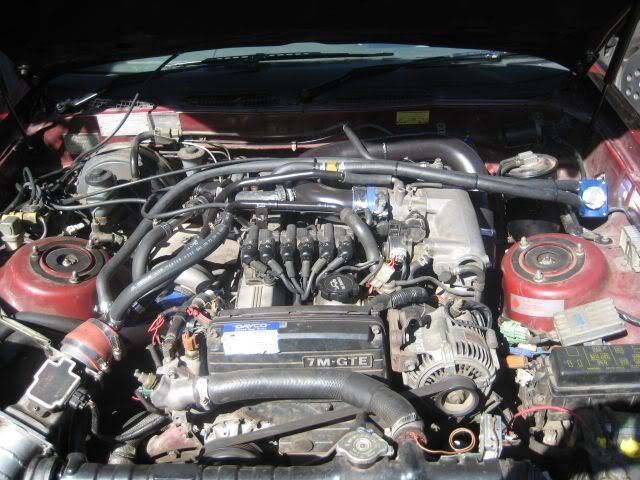Okay, well, I was thinking about electric fans, and of course the problem is, how to control them. I've got an idea for this, and would like some feedback on the idea. I want to build an electric fan controller, which would trigger a relay to provide 12V to a set of electric fans.
In my car, I've got a Koyo radiator. This is relevant only because it's a 1JZ radiator, and therefore had the hole for the temp sender in the bottom. I don't know what the nature of this sender is, but I know that a 16mm by 1.25mm plug makes it perfectly suitable for 7M usage. I figure that I can't be the only one with something like this, so it's a decent basis to start from.
My thought was that putting in a temperature sending unit for an electric temp gauge in that location would give feedback on how the radiator is working. If the car is still cold, then the coolant at the bottom of the radiator would be cold. Even once the car warms up, if the car is moving fast enough, then the radiator should be working well enough without needing assistance from the fans, and the coolant at the bottom of the radiator should be at an acceptable temperature.
If we then use a Schmitt trigger to turn on the fans when the coolant at the bottom of the radiator gets hotter, and keep them on until it cools, this ought to be ideal, running the fans for the least amount of time needed in order to do an adequate job.
So, what do people think should be a good temperature to turn the fans on at, and when is it cool enough to turn them back off?
Temp at the water neck should remain at whatever the thermostat temp is, so 170~190 deg F. I figure that the temp at the bottom of the radiator should never exceed about 150 deg F under any circumstances (And was planning a "radiator over temp" output to trigger an idiot light which would warn the driver BEFORE the car overheats.)
I was figuring on drilling a 1/8" NPT tapped hole into a 16mm drain plug and putting in a standard temp sensor from an inexpensive water temp gauge.
Also, would the radiator need additional grounding? (The coolant should be a fairly good conductor to engine block ground, but is it good enough to rely on?) I think that the radiator mounts are insulated with rubber, so I don't think that there is a ground to the radiator tanks which can be counted on.
In my car, I've got a Koyo radiator. This is relevant only because it's a 1JZ radiator, and therefore had the hole for the temp sender in the bottom. I don't know what the nature of this sender is, but I know that a 16mm by 1.25mm plug makes it perfectly suitable for 7M usage. I figure that I can't be the only one with something like this, so it's a decent basis to start from.
My thought was that putting in a temperature sending unit for an electric temp gauge in that location would give feedback on how the radiator is working. If the car is still cold, then the coolant at the bottom of the radiator would be cold. Even once the car warms up, if the car is moving fast enough, then the radiator should be working well enough without needing assistance from the fans, and the coolant at the bottom of the radiator should be at an acceptable temperature.
If we then use a Schmitt trigger to turn on the fans when the coolant at the bottom of the radiator gets hotter, and keep them on until it cools, this ought to be ideal, running the fans for the least amount of time needed in order to do an adequate job.
So, what do people think should be a good temperature to turn the fans on at, and when is it cool enough to turn them back off?
Temp at the water neck should remain at whatever the thermostat temp is, so 170~190 deg F. I figure that the temp at the bottom of the radiator should never exceed about 150 deg F under any circumstances (And was planning a "radiator over temp" output to trigger an idiot light which would warn the driver BEFORE the car overheats.)
I was figuring on drilling a 1/8" NPT tapped hole into a 16mm drain plug and putting in a standard temp sensor from an inexpensive water temp gauge.
Also, would the radiator need additional grounding? (The coolant should be a fairly good conductor to engine block ground, but is it good enough to rely on?) I think that the radiator mounts are insulated with rubber, so I don't think that there is a ground to the radiator tanks which can be counted on.

